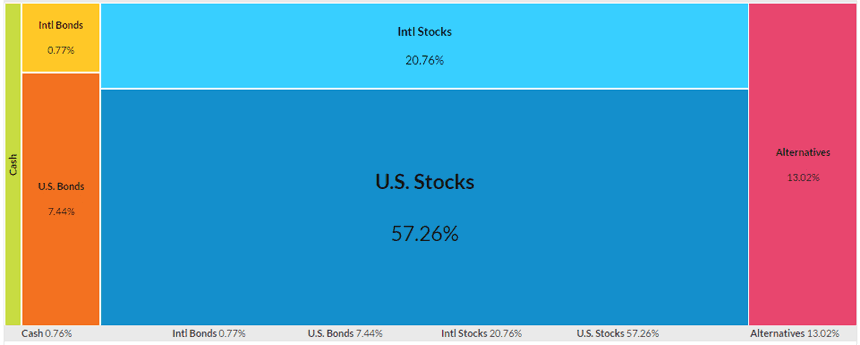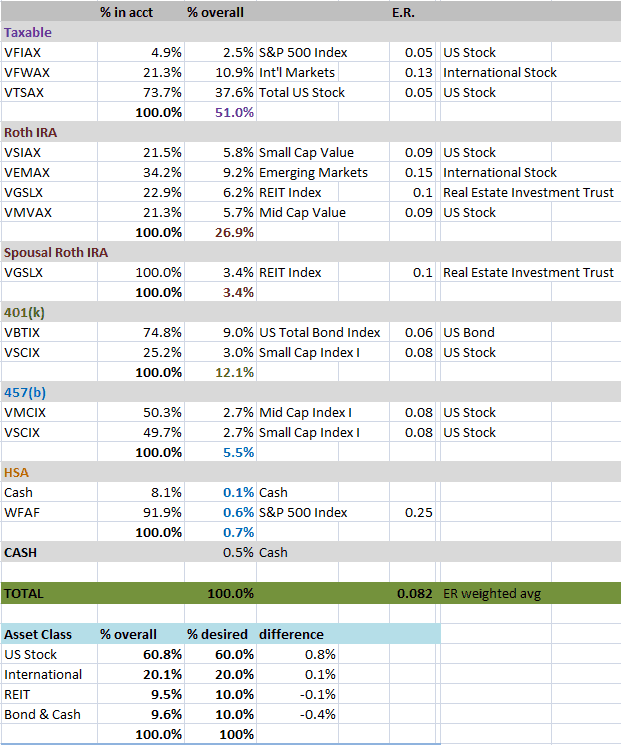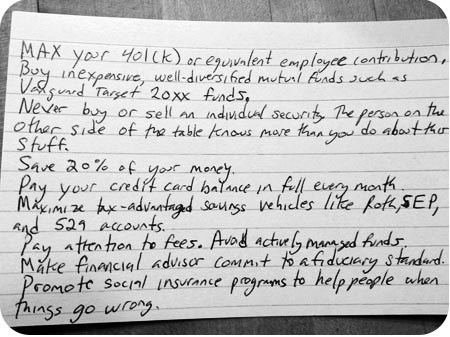
20 Steps to Effective DIY (Do It Yourself) Investing
This post may contain links from our sponsors. We provide you with accurate, reliable information. Learn more about how we make money and select our advertising partners.
This Today’s Classic post is republished from Physician on Fire. The original post can be found here. Physician on Fire has just been an awesome resource for anyone interested in investing their finances wisely. This is one of my favorite posts of his and is one I'll read again and again for sure. In fact, I recommend you bookmark this (Do it now!), in case you or anyone is planning on investing either DIY or even with an advisor. Enjoy!
You’ve got a great job. You’re making your monthly debt payments to pay down student loans and the mortgage, perhaps making additional payments on the interest. You’re living a life of relative frugality and you’re keen on achieving financial independence. Now you’re ready to start investing.
But you’re not sure where to start.
You’ve heard that fees can devour your gains and that the perfect financial advisor is hard to find. You decide to do it yourself (DIY). You were smart enough to get into medical school, and diligent enough to complete a rigorous residency.
You can do this. Here’s how to get started.
20 Steps to an Effective DIY Investment Plan
1. Read a book.
Or two or three. The internet is full of great information, but it can be difficult to know where to begin. A good basic personal finance book is organized into a cohesive package of well-written and professionally edited chapters designed to teach you what you need to know and understand to be comfortable managing your money.
A few I can recommend:
- The Only Investment Guide You’ll Ever Need by Andrew Tobias. The first investing book I read. An updated edition was just published April 26, 2016.
- The Little Book of Common Sense Investing by John Bogle. It’s not a how-to guide, but it gives a good overview of how the markets work, with some fun parables and loads of wisdom from an investing hero.
- The Bogleheads’ Guide to Investing by Taylor Larimore, Michael LeBouf, and Mel Lindauer takes the logic and ideologies of ‘Saint’ Bogle and applies them to everyday investing for people like you and me.
- The White Coat Investor: A Doctor’s Guide To Personal Finance And Investing by James Dahle, MD. Read my book report here. This is probably the best book for financial advice specifically for physicians.
2. Harness the power of the internet.
Once you have some baseline knowledge from reading a book or two, refine that knowledge with a little browsing. Read some articles and blog posts. Read the forums. When you’re ready, ask questions on the forums. You’ll be amazed at the quality information you’ll receive on a quality forum, two of which are listed below.
A few sites to get you started:
- Bogleheads. An extensive wiki and a great forum.
- WhiteCoatInvestor. five years of great posts and an active forum.
- Rockstar Finance. Features three inspiring posts daily Monday – Friday.
- The Finance Buff. 10 years and > 700 intelligent posts.
- Physician on FIRE. Shameless self promotion. Move on.
3. Estimate your net worth.
It’s hard to figure out how to get somewhere if you don’t know where you are starting from. Look up your balances and add them up. Add home equity if you’ve got any. Look up your debts and subtract them from the assets.
Anonymous people on some internet forums like to quibble about what to include and exclude in the calculation. What about jewelry? And art? The Beanie Baby collection?!? I like to stick with property, cash, and investments, but whatever you decide to use, be consistent.
I like to use Personal Capital* to track all of my accounts in one place. The site / app gives you lots of different ways to view and analyze your investments. Mint is lighter on the investment side, but more robust on budgeting and expense tracking if you’re into that kind of thing.

Personal Capital breaks down my asset allocation with pretty colors
4. Determine your risk tolerance.
Harnessing the power of the internet in a different way, take a quiz to determine how comfortable you are in taking calculated risks with your investment portfolio.
Here are a few resources to help you with this task:
- Vanguard – Investor Questionnaire
- Merril Lynch – Risk Tolerance Evaluator
- Yahoo – What is my Risk Tolerance?
- Wells Fargo – Risk Tolerance Quiz
- Index Fund Advisors – Risk Capacity Survey
Use the answers to determine a ratio between stocks and bonds for your portfolio. The quizzes are a guide. Some people use simple formula, such as “age in bonds” (70% stocks / 30% bonds for a 30-year old) or a more aggressive version, i.e. “age minus 10” in bonds or “age minus 20” in bonds.
When breaking down your portfolio into two broad categories, the “stocks” allocation includes US and International Stock funds, and alternatives such as REIT. The “bonds” portion includes fixed income vehicles including bonds, CDs, and cash.
I have decided on 90% stocks / 10% bonds for now. You do what works for you.
5. Decide if you want international stock and bond exposure.
The aforementioned John Bogle of Vanguard fame has stated that international funds are not a necessity in the average investor’s portfolio. Interestingly, Vanguard’s target date funds recently increased the international portion of its target date and all-in-one funds to 40% in 2015.
While it is true that many American companies do substantial business overseas, and owning them gives you some international exposure, there are some very large corporations based outside of the United States, particularly in developed markets throughout Europe and Asia.
Recommendations for international allocations range from 0% to 40% or more. I’ve decided to allocate 20% of my portfolio to international stocks, or 25% of my stock allocation.

6. Decide if you want Real Estate Investment Trust (REIT) exposure.
Ownership in an REIT or a fund of REITs is a way to profit from real estate without the hassles of managing rental property yourself. It’s also a good way to diversify your portfolio. While there is some correlation with the overall stock market, over the long term, it tends to be rather low, at least according to this article from Financial Advisor Magazine.
If buying, renting, and selling actual real estate is part of your “investment” plan, I suppose you should determine how that’s going to work at this point. I’m not going to speak much to that, as it is not my area of expertise, and I consider that to be a form of part-time or full-time work more than an investment. This post is designed to help you create a simple, hands-off DIY investment plan. Landlording is not a part of that plan.
I’ve chosen to allocate 10% of my portfolio to Vanguard’s REIT index (VGSLX), although it has come to my attention about 3.6% of Vanguard’s Total Stock Market Index (VTSAX) and 16.4% of their Small Cap Value Index Fund is in REIT, so my exposure actually exceeds 10%, as evidenced by 13.02% in “alternatives” in the colorful diagram above.
For further reading on asset allocation, check out the Bogleheads lazy porfolios, including the three-fund and four-fund portfolios.
At this point, you should have your target asset allocation nailed down. You’ve got mine, too (60% US stock, 20% international stock, 10% REIT, 10% bond).
7. Learn about tax-efficiency.
Hooray! you’ve got your very own tailor made asset allocation. Now keep in mind that you will have multiple retirement and non-retirement (taxable / brokerage) accounts. You aren’t going to try to recreate your desired allocation in each account. You will apply the asset allocation across all accounts.
Tax-efficient fund placement describes a manner in which your assets are placed in the accounts which will provide the best (or least deleterious) tax consequence. Tax-inefficient assets that would be taxed the most are sheltered in a tax-deferred or tax-free (Roth) retirement account.Tax-inefficient funds include REIT funds, actively managed mutual funds with high turnover, and high-yield bond funds.
The most tax-efficient funds will be ideal choices for a taxable account. These include municipal bond funds, passive stock index mutual funds, and international stock funds with low turnover (index funds). Including tax managed funds such as municipal bonds in a tax sheltered account can be counterproductive. You are sacrificing yield for a tax benefit that won’t be fully realized.
International funds will generate a foreign tax credit that you can report to the IRS and typically subtract dollar for dollar on your 1040. Growth funds tend to be more tax efficient than value funds, due to lower dividend payments.
8. Explore your work-related retirement savings options.
If you are employed, you likely have access to a 401(k) or a similar account which could be a 403(b) or 401(a). You may also have access to a deferred compensation plan such as a 457(b), or a cash-balance plan.
If you are self-employed, a solo 401(k) is an attractive option. Others exist, such as SEP-IRA, SIMPLE IRA.
A full explanation of each of these options is beyond the scope of this article, but you owe it to yourself to understand what options you as an individual have, and read up on those. Hopefully your book reading in Step 1 gave you some background information. If not, jump to Step 2 and use the internet to your advantage.
Ideally, you’ll have quality, low cost funds available to you (because fees can cost you millions). Unfortunately, some 401(k) and similar plans have no good options. If you’re trying to choose from a list of crummy funds, WCI has a write-up that can help guide you. If the funds are really bad, and you have no match (as is typical with a 457(b)), you may consider not contributing to the account at all. Always contribute enough to get the match where one exists. Never turn down free money.
9. Decide Roth versus Traditional for your work-related plans.
Some plans will allow you to make traditional (tax deferred) contributions to your 401(k) and similar plans, or Roth (taxed now, not later) contributions, or a combination of the two. If you are unsure, check with your plan administrator or human resources department.
I love Roth money. I love it so much I slashed my net worth by over $200,000 to have more. But if you are earning a physician’s salary, you’re probably better off with traditional contributions, taking a tax deduction now while you are in a high tax bracket. The future is uncertain, but most of us can expect to be in a lower tax bracket in retirement. This is especially true if early retirement is potentially in your future. It’s not unreasonable to plan to live quite comfortably and pay zero federal income tax as an early retiree.
If you plan to work for 30+ years, maxing out all your tax deferred space, you could easily end up with millions. Your impressive balance will ensure that you remain in a high tax bracket starting the year after you turn 70.5 and Required Minimum Distributions are in place. If this is you, Roth contributions would be a reasonable consideration, despite your lofty current tax bracket.
10. Determine if you have money left over.
One of the best features of accounts like a 401(k) is that you never see or handle the money. It’s invested on your behalf without a pit stop in your checking account. What you do with the other money that comes in the form of a paycheck is up to you. You may be aggressively paying down debt, or saving for a down payment on a home, or a grand vacation.
If your debt payments are made, and your needs are met, and you find yourself with money left over, great! Don’t let it burn a hole in your pocket. Let’s put that money to good use.

11. Start a Roth IRA
This Roth contribution is different than the potential Roth contributions we talked about in Step 9. In that case, the alternative was a desirable tax deferred contribution to a retirement account. In this case, we’re assuming you’ve maxed out your retirement accounts, and have money left over. The alternative to this Roth contribution is a contribution to your taxable account (See step 12).
Many physicians will be ineligible for a direct contribution to a Roth IRA. For a single filer, the phase-out begins at a modified adjusted gross income (MAGI) $117,000 and is complete at $132,000. For married joint filers, the numbers are $183,000 and $193,000, respectively.
Do you have the fortunate problem of earning too much? There is good news for you and it’s referred to as a backdoor Roth IRA. It’s a sort of loophole, but it’s a poorly kept secret. The loophole could be closed, so take advantage while you still can.
For a very detailed explanation of how the “backdoor Roth” works, visit Michael Kitces’ instructions here. The “index card” version is this:
- Make a $5500 non-deductible after-tax contribution to a traditional IRA account. Repeat in a spousal account if you’ve got one.
- On a later date, convert the contribution to Roth.
- Be sure to submit Form 8606 with your 1040 to report the after-tax IRA contribution.
- The net result is the equivalent of a $5500 Roth IRA contribution (or two), and it can be done at any income level.
Bonus reading: You may have heard of the Mega Backdoor Roth IRA. I looked into it and it’s not an option via my retirement plan. But if your plan allows it, it can be a sweet deal.
12. Start a taxable account.
A taxable account sounds like a bad idea, much like spinal anesthesia, but like spinal anesthesia, it is a good option associated with a scary word.
Also referred to as a brokerage account, or after-tax account, this is simply a collection of investments you buy with money left over after you’ve exhausted your tax-advantaged options.
Although dividends and capital gains in this account can be subject to taxes, there are good ways (keep taxable income low) and bad ways (death) to minimize or completely avoid those taxes. If you are paying taxes on them, they won’t hurt you that badly. I live in a high-tax state and the tax drag on my taxable account in the accumulation phase is approximately 0.5% per year.
If you were paying attention in Step 7, you will fill your taxable account with passive index funds, including international funds if you chose to include them in your portfolio. Municipal bond funds can be a good option too, especially if you can find one that is also tax-free in your state.
13. Create a spreadsheet to track the money in different accounts.
Personal Capital will give you all the balance and allocation information you can ask for, but nothing will be as flexible as a well-designed spreadsheet. A simplified version of the one I use looks like this. It does a great job helping me allocate my desired asset allocation across different accounts in a reasonably tax-efficient manner.
If you’re not an Excel junkie, this is one of the steps I will allow you to skip. When I find time, I will attempt to make a generic version of this to share with you, as has been requested by one of our readers. I had this before I had online tools, so I still like to use it. Lately, I find myself logging in online to check balances most days, and updating the master spreadsheet every couple months.
14. Sweat the Details
If you’ve followed the first 13 steps, you’ve probably come across some recommendations in your reading that you’d like to implement in your portfolio. You’ve got a plan that will allow you to be a successful DIY investor, but there is some fine tuning you’d like to enact.
Now is the time to do that. Slice and dice. Implement a small value tilt in your U.S. stocks or an emerging market tilt in international. Plan for future tax-loss harvesting in your taxable account. Weigh the merits of various fixed income options like CDs, TIPS, I Bonds, and bond index funds. These details aren’t going to make or break you, but you want to have a plan, and this is your opportunity to make it your own.
15. Allocate up to 5% of your portfolio to “play money”
Index investing is boring. You’re not going to hit any home runs or beat the indexes. Of course, you will get market returns, which is better than most active managers do, as Boglehead Larry Swedrroe demonstrates in Swedroe: Active Funds Whiff Again.
But you want a home run. You want to pick stocks; you want to invest in the healthcare sector because you work in the healthcare sector. You want to be an angel investor. You want to be like me and own part of a microbrewery. Or a restaurant or distillery. The guy in Blindside owned Taco Bells and had a proper mansion.
These investments may offer a higher reward, but the potential reward is often paired with a side of equal or higher risk. A common recommendation is to limit these investments to 5% of your portfolio. If you have a basket of many individual stocks that is reasonably diversified, you don’t have to count that as part of your play money. Doubling down on biotech is another story. Have fun but don’t bet the microbe farm.
16. Insure yourself
A good investing plan can be thwarted if your assets are not protected from loss.
- Insure against loss of life with term life insurance.
- Insure against loss of the ability to work with disability insurance.
- Insure your homes and cars with home and auto insurance.
- Insure against malpractice lawsuits with appropriate malpractice insurance
- Insure against everything else with umbrella insurance.
Don’t spend money insuring things you can afford to replace yourself, like your cell phone and other electronics. Insure against catastrophes, not inconveniences.

If you’re completely Financially Independent, you can afford to live without some of these, notably life insurance, and costly disability insurance. Pete Adeney, a.k.a. Mr. Money Mustache has the audacity to forego home insurance. That’s not a bet I’m ready to make, although I have raised my deductible to $10,000 to lower my annual rate.
17. Rebalance at pre-determined intervals
As time goes on, your investments in different asset classes will grow and shrink at different rates. Eventually your tidy 60 / 20 /10 /10 split will look something like a disheveled 58 / 23 / 7 / 12. This is where rebalancing comes into play to right the ship.
There are different approaches to rebalancing as outlined in the Bogleheads wiki. Choose one and stick with it. Your options are to rebalance with new additions (or withdrawals in retirement), at set time intervals (quarterly, semi-annually, annually), or when the balance is off by a certain relative or absolute percentage.
The beauty of rebalancing is that it forces you to buy low and sell high. When one asset class has performed well, you will have more of it. You sell some, capturing the gains, and buy more of an underperforming class that is priced low. Rebalancing too often tends to minimize this effect.
18. Decide if a Donor Advised Fund is right for your charitable giving.
You’ve made it through the first 17 steps. If you’ve got a decent income and savings rate, you’re on a path to real wealth. It’s time to think about how to share the wealth (and I’m not talking about taxes this time).
I like to do things optimally, and my charitable giving strategy is no exception. I’ve written about the benefits of utilizing a donor advised fund (DAF), and half of this site’s profits will be donated to charity. I have used several companies’ DAFs, but find Fidelity’s to be my favorite, thanks to low costs and the lowest minimum grant of $50, as compared to Vanguard’s minimum of $500.
When you give to a donor advised fund, you receive an immediate tax deduction when you contribute, and you can donate the money at any time in the future. The tax treatment of your donation can be further optimized by contributing appreciated funds from your taxable account rather than cash. Capital gains will not be incurred by either the giver (you) or the recipient. A win win.
19. Consider your drawdown plan
As you build up your assets, keep in mind you’ll eventually be tapping into them to live a good life in retirement. Knowing which trees to tap and when to tap them can affect your overall harvest. If you’re planning to retire early, and all your assets are in a 401(k), you’re going to have to be a little more creative than your colleague with a sizable taxable account.
Knowing where your money is, how it can be accessed, and what the tax consequences are will allow you to come up with a sensible drawdown strategy to allow for retirement spending.
Here’s mine:
- Set up 457(B) to pay $$2,000 to $3,000 / month.
- Receive dividends and capital gains as cash transfers to bank account.
- When cash is needed, sell taxable assets and minimize / optimize capital gains.
- Attempt to keep taxable income low enough avoid taxes on capital gains (~$78,000 in 2018).
- Convert 401(k) / IRA to Roth as income / tax bracket allows.
- Donate appreciated securities to Donor Advised Fund when needed to maintain low tax bracket.
- At 59.5, evaluate 401(k) / IRA and estimate RMD’s, which kick in age 70.5.
- Anticipate delaying Social Security to get the maximum benefit, assuming good health.
- Pay for boys’ college with $2,000 to $4,000 cash (to obtain tax credits), then tap 529’s.
Come up with your own and incorporate it into your Investor Policy Statement. “Wait, my what?”
20. Write a simple Investor Policy Statement.
This Step might scare you off. It shouldn’t. Keep it simple. I’ve written about my IPS a couple times now. It started out simple, and has grown with me as my knowledge base has expanded, and my plan has become more finely honed.University of Chicago professor Harold Pollack wrote his on an index card, and it went viral. The card’s popularity spawned a co-authored 256-page book entitled The index Card: Why Personal Finance Doesn’t Have to Be Complicated. I’ll add this to the list of books I haven’t read, but would love to when I find the time. With a 4.5 star rating on Amazon, it might be good enough to land itself in the list of go-to resources in Step 1.

You’re almost done. Write down 5 to 10 sentences based on the knowledge you’ve gathered so far. Set it aside for now, and revisit annually. Expand it and modify it occasionally as your investing acumen grows and your situation changes.
That’s it! From zero to DIY investing hero in 20 steps. I’m rather proud of this one… please consider leaving it up on the screen in the lounge or share with a friend who could benefit from learning a thing or two.
What did I leave out? Things that are optional or don’t apply to everyone, like college savings and student loan repayment strategies. Asset protection and estate planning are further steps a DIY investor can explore once the basics are covered, but again, are beyond the scope of this 3,700 word post. You wouldn’t want this to go on any longer, would you? OK. Me neither.
Disclaimer: The topic presented in this article is provided as general information and for educational purposes. It is not a substitute for professional advice. Accordingly, before taking action, consult with your team of professionals.

